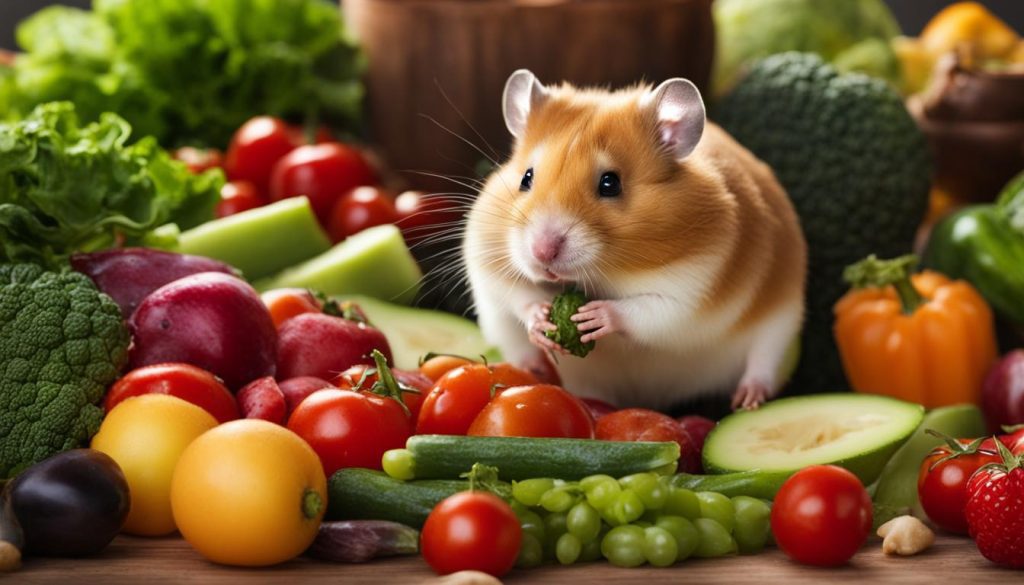As a hamster owner, you may have wondered if it’s safe to include meat in your furry friend’s diet. Hamsters are omnivores, which means they can eat both plant-based and animal-based foods. While hamsters can obtain most of their nutrients from a pellet-based diet, incorporating meat can provide certain benefits, including essential proteins for muscle development and stimulation. However, it’s important to understand that not all meat is suitable for hamsters and proper preparation is crucial.
When it comes to choosing meat for your hamster, opt for light meats like fish or chicken as they are easier to digest compared to red meat. Serving the meat plain, without any spices, oil, or seasoning, is essential to ensure your hamster’s safety. Cooked meat should be given in moderation as a treat, with a thumbnail-sized portion being sufficient. Remember, the ideal hamster diet consists of a balanced combination of commercial hamster pellets, hay, fresh vegetables, fruits, and herbs.
Can Hamsters Eat Meat? Yes, they definitely can!
- Hamsters are omnivores and can eat meat as part of their diet, but it’s not essential.
- Light meats like fish or chicken are easier for hamsters to digest compared to red meat.
- Serve the meat plain, without spices, oil, or seasoning, and in moderation as a treat.
- The ideal hamster diet includes commercial hamster pellets, hay, fresh vegetables, fruits, and herbs.
- Always consult with a veterinarian for specific dietary recommendations for your hamster.
Benefits of Eating Meat for Hamsters
Incorporating meat into a hamster’s diet can provide several benefits for their overall well-being. One of the key advantages is the inclusion of animal protein, which plays a vital role in promoting muscle development and growth in hamsters. Protein is made up of amino acids, which are essential for maintaining healthy muscle function and supporting proper growth.
By adding meat to a hamster’s diet, they can obtain these necessary amino acids, which contribute to their muscle development and help keep their bodies strong and agile. Hamsters have an innate hunting instinct, and including live insects such as crickets and mealworms can provide them with mental stimulation and physical activity as they engage in natural hunting behaviors.
In addition, introducing meat into a hamster’s diet adds variety to their meals, making it more enjoyable for them. Different textures and tastes can keep their eating experience interesting and prevent them from getting bored with their food. Offering a diverse range of food options helps ensure that hamsters receive a well-rounded diet that meets their nutritional needs.

However, it’s important to note that while meat can bring several advantages to a hamster’s diet, it is not an essential component. A balanced hamster diet can be achieved primarily through commercial hamster food, which is specially formulated to meet their nutritional requirements. Meat should only be given as an occasional treat, in small portions, to avoid any potential digestive issues or imbalances in their diet.
Risks and Considerations When Feeding Hamsters Meat
Feeding meat to hamsters comes with certain risks and considerations. It’s important to understand the potential hazards and take appropriate precautions to ensure the well-being of your furry friend.
Digestion and Meat Sources
Some meat sources, especially red meat, can be harder for hamsters to digest compared to lighter meats such as fish or chicken. Hamsters have delicate digestive systems, and their bodies may struggle to process certain types of meat. To minimize the risk of digestive issues, it’s best to choose lean, light meats as safe options for your hamster.
When selecting meat for your hamster, it’s essential to prioritize their safety. Avoid processed meats, as they often contain added preservatives and high levels of salt, which can be harmful to hamsters. Instead, opt for fresh, high-quality meat from trusted sources. Remember, the quality of the meat directly influences your hamster’s health and well-being.
Preparing the Meat
Properly preparing meat is crucial when feeding it to hamsters. First and foremost, it’s important to serve the meat plain, without any spices, oil, or seasoning. Hamsters have sensitive taste buds and can be adversely affected by added flavors and ingredients that are commonly used in human food.
Additionally, be sure to cook the meat thoroughly to eliminate any potential bacteria or parasites that could be harmful to your hamster. Raw or undercooked meat can lead to digestive upset and increase the risk of bacterial infections. Always cook meat until it is fully cooked and safe for your hamster to consume.
Another important consideration is to remove any bones before serving meat to your hamster. Bones can pose a choking hazard and may cause injury to their delicate digestive tracts. Ensure that the meat you offer is boneless, minimizing any potential risks.
Portion Size and Moderation
When feeding meat to hamsters, it’s crucial to remember that moderation is key. While meat can provide additional protein and nutrients, it should be given in small amounts as a treat, not as a primary food source. A thumbnail-sized portion of meat is sufficient for a hamster’s needs.
Offering meat to your hamster as an occasional treat can provide enrichment and variety in their diet. However, it’s important to note that meat is not a requirement for a hamster’s nutrition. A balanced diet consisting of commercial hamster food, fresh vegetables, fruits, and herbs can sufficiently meet their nutritional needs.
By considering the risks and taking appropriate precautions, you can safely incorporate meat into your hamster’s diet. Always consult with a veterinarian to ensure you are providing the best dietary choices for your hamster’s individual needs.
Safe Meat Sources for Hamsters
When it comes to choosing meat sources for your hamster, safety is paramount. Opting for light meats such as fish or chicken is generally a better choice, as these are easier for hamsters to digest. It’s important to serve the meat plain, without any seasoning or spices, to avoid any potential harm to your furry friend’s delicate digestive system.
In addition to poultry and fish, another option for safely incorporating meat into your hamster’s diet is through live insects. Crickets and mealworms, for example, can provide a natural and enjoyable form of animal protein for your pet. Not only do these insects offer nutritional benefits, but they also offer stimulation and entertainment as hamsters engage in their natural hunting behavior.
When introducing insects as a meat source, it’s important to ensure their safety as well. Source them from reputable suppliers to guarantee that they are free from pesticides or parasites that could harm your hamster. Prioritizing the well-being and dietary needs of your furry friend will contribute to a happy and healthy life!

The Ideal Hamster Diet
When it comes to the ideal hamster diet, a combination of commercial hamster pellets, fresh vegetables, fruits, and herbs is key to providing your furry friend with a balanced and nutritious meal plan.
Commercial hamster pellets should make up a significant portion of your hamster’s diet, as they are specially formulated to meet their nutritional needs. These pellets provide the necessary balance of proteins, vitamins, and minerals to keep your hamster healthy and happy.
In addition to pellets, fresh vegetables are an essential part of your hamster’s diet. Vegetables like broccoli, peas, spinach, and carrots can be given in small quantities to provide additional vitamins and minerals. These veggies not only offer a variety of textures and flavors for your hamster, but they also contribute to their overall well-being.
While fruits are a tasty treat for hamsters, they should be offered in moderation due to their sugar content. Occasional treats like apple, blueberries, melon, and peach can be given in small portions to add a touch of sweetness to your hamster’s diet.
Another great addition to your hamster’s diet is herbs and flowers. Safe options include dandelion leaves, chickweed, grass, calendula petals, and white clover. These natural herbs and flowers provide additional nutrients and can contribute to your hamster’s overall health and well-being.
Remember, it’s important to provide a varied and balanced diet to ensure your hamster receives all the necessary nutrients for optimal health. By incorporating a combination of commercial hamster pellets, fresh vegetables, fruits, and herbs, you can create an ideal meal plan for your furry friend that promotes their well-being and satisfies their taste buds.
Conclusion
Incorporating meat into a hamster’s diet can provide certain benefits, such as animal protein for muscle development. However, it is important to choose safe meat sources, such as light meats like fish or chicken, and serve them plain and thoroughly cooked to ensure the hamster’s safety. Meat should be given in moderation, primarily as a treat, as hamsters can meet their nutritional needs with a balanced commercial hamster food. It is also crucial to provide a varied diet that includes fresh vegetables, fruits, and herbs to ensure the hamster receives all the necessary nutrients.
When considering the hamster’s diet, it is always recommended to consult with a veterinarian who can provide specific dietary guidelines based on the hamster’s individual needs. They can help determine the ideal feeding plan, considering factors such as the hamster’s breed, age, health, and size. Following proper hamster feeding guidelines, including a safe and balanced diet, will contribute to the hamster’s overall health and well-being.
Remember, a safe diet for hamsters prioritizes the right balance of nutrients and provides variety to keep them healthy and happy. By ensuring a balanced diet that includes commercial hamster food, fresh vegetables, fruits, and herbs, you can provide your hamster with the best possible nutrition. Pay attention to your hamster’s individual needs and consult with a veterinarian for personalized recommendations. With a proper diet and care, your hamster can thrive and live a happy, healthy life.
FAQ
Can hamsters eat meat as part of their diet?
Yes, hamsters can eat meat as part of their diet. However, not all meat is suitable for hamsters, and it should be given in moderation as a treat.
What are the benefits of eating meat for hamsters?
Meat provides animal protein, which is essential for muscle development and growth in hamsters. It also adds variety to their diet and offers different textures and tastes.
Are there any risks or considerations when feeding hamsters meat?
Yes, some meat sources may be harder for hamsters to digest. It’s important to serve plain cooked meat, without any seasoning, and in proper portion sizes. Bones should be removed to prevent choking.
What are safe meat sources for hamsters?
Light meats like fish or chicken are generally safer for hamsters to eat. Live insects such as crickets and mealworms can also serve as safe meat sources for hamsters.
What does the ideal hamster diet consist of?
The ideal hamster diet includes commercial hamster pellets as the main source of nutrients, along with fresh vegetables, fruits, and herbs as supplementary foods.
Is meat essential in a hamster’s diet?
No, meat is not essential in a hamster’s diet. Their nutritional needs can usually be met with a balanced commercial hamster food.






